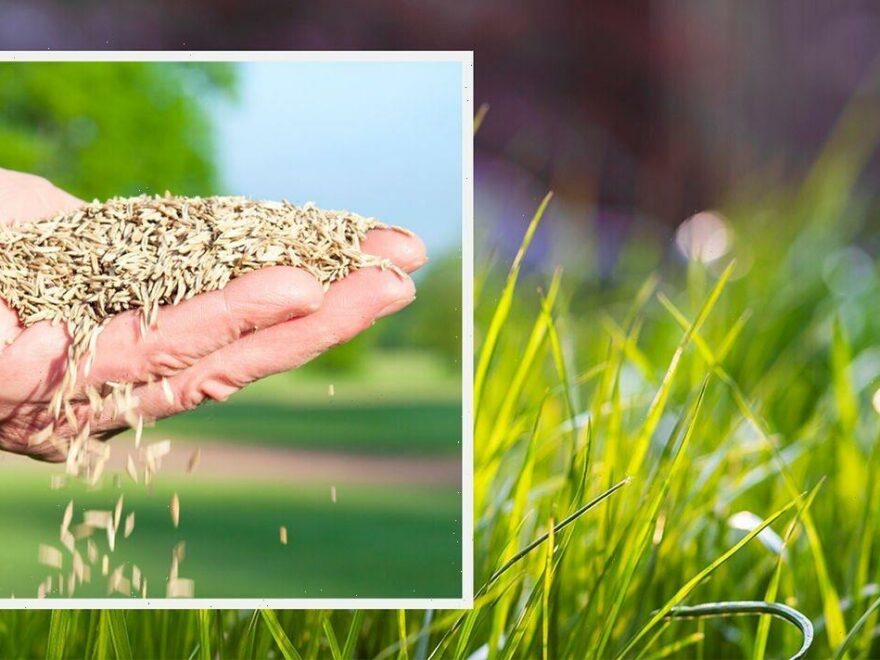
We use your sign-up to provide content in ways you’ve consented to and to improve our understanding of you. This may include adverts from us and 3rd parties based on our understanding. You can unsubscribe at any time. More info
Grass seed is a great way to refresh a patchy lawn, but can gardeners achieve thick full grass? Express.co.uk spoke to Carlos Real, Gardening Expert and Managing Director of TotalLawn, who shared his step-by-step guide to using lawn seed to achieve the “lawn colour of your dreams”.
1. Clear the area
Carlos explained: “Begin the process by clearing the area – whether that’s pre-existing grass, weeds, paving, or anything else that might be in the space.
“Pull out weeds or invest in a weedkiller to make sure there’s no remains.
“If you do use a weedkiller, allow two to four weeks to pass before sowing new seed.”
2. Create the base and level, level, level
If there’s a large area of ground that is to be sown, a base needs to be created.
“A 15-25cm base of good quality, free draining topsoil works best,” the gardening expert said.
“Then comes the most important part: levelling. The best way to check your ground is level is by inserting four rods into the ground in a square and tying a string around the four connecting rods – be sure that it’s tight.
“Use a tape measure to check that the height from the ground is consistent from all four sides, if it isn’t you’ll be able to see how much you need to adjust the ground to make it level.
“I find a lute is a much easier tool to use than a rake, but both are sufficient – so use whatever you can find.”
3. Apply a pre-seed fertiliser
“Pre-seed fertilisers are designed to give your soil all the vital nutrients it needs to support the first few weeks of growth,” Carol revealed.
“A low-nitrogen, pre-seed fertiliser works best.
“Each pack contains enough for 50m2 – tip: to figure out the rough size of your lawn, simply pace long strikes across the widest part, then the same on the longest and multiply the two numbers together, for example five paces x 10 paces = 50 square meters.”
“Application can be done by hand, so there’s no need to spend money on unnecessary equipment.
“In most cases I will actually mix the pre-seed fertiliser in a bucket with the seed to ensure the mix is even.
“Simply measure out the appropriate quantities of seed and fertiliser and mix them in a bucket.”
4. Sow your seeds and water them in with a light spray
Carlos continued: “Choosing the right seed for your lawn is simple – it all depends on the aesthetic you are trying to achieve.
“For example, if you need a hard-wearing lawn that must withstand children and/or pets, you will want a seed with high rye content.
“With seeding, it’s easier to control the blend and find a combination that’s right for your lawn.
“Choose a non-windy day to sow seed to avoid seeds in areas you don’t want.
“If seeding by hand, mark out the area (note 1kg covers 20m2 if seeding a new lawn or 50m2 for overseeding) – this will show you how densely you need to sow the seed.
“As with all seeds, make sure to check the packaging instructions for the recommended rate of application – don’t be tempted to over-seed as this will cause many of the seeds to rot, and you’ll be paying more in the process.”
Carols added: “Once applied, lightly rake the area to mix the seed and soil.
“Apply another layer of topsoil over the top of the seeds to protect them from birds and to hold moisture.
“Water the seeds in with a light spray to start the germination.
“You want to get a good soil-to-seed contact, so I suggest lightly treading the seed into the soil, or use a light garden roller to push them into the ground.”

5. Deploy some bird deterrents and keep the seeds moist
“Whatever your preferred method, it’s important to protect your new seeds from birds,” the lawn expert suggested.
“The best options include netting 20cm above the soil, a scarecrow, or even a hungry cat.
“If it hasn’t rained in the 24-48 hours after seed application, give the area a soaking (but avoid creating puddles/washing the seeds away, and use the fine mist setting on your hose to prevent damage to the seeds), and then keep the seeds moist for two to three weeks.”
6. Mow and maintain
“Depending on the time of year and growth rate, carry out your first mow four to six weeks later – it should be between 5cm and 8cm,” Carlos said.
“It’s important to remember that your new lawn will look patchy at first, but after the first cut the grass will be encouraged to grow and fill the gaps.
“The process of getting a new lawn is relatively simple – the key to success is ensuring that the ground is as level as possible before you start, and that you keep the grass well-watered in those first few weeks while the roots are establishing themselves.”
View this post on Instagram
A post shared by TotalLawn (@totallawnofficial)
About Total Lawn
Founded in 2019 by school friends Carlos Real and Joshua McNicholas, TotalLawn, are the leaders in premium luxury lawn care.
Creating scientifically engineered lawn care products, TotalLawn prides itself on giving you the best lawn possible, without the fuss.
GARDENING
Source: Read Full Article
